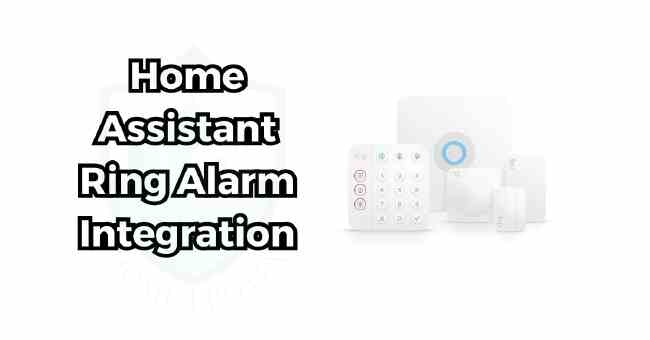Table of Contents
How can you make home assistant Ring Alarm integration works together? Yes, You absolutely can connect these two powerful platforms to supercharge your home automation capabilities and customize your security system.
As a busy dad trying to keep my family safe, I struggled for weeks to get my Ring devices properly integrated with Home Assistant.
I was so close to giving up out of frustration until I finally had a breakthrough. Once it clicked and everything synced up, I was blown away by the new level of control and automation I had achieved. The effort it took was completely worth it in the end.
Throughout this article, I’ll take you through the steps I wish I knew earlier to seamlessly integrate Ring Alarm with Home Assistant.
I hope my experience can shortcut the learning curve and help you automate your home security!
An Overview of Ring Alarm and Home Assistant
For those new to home automation, let’s start with a quick overview of the main platforms we’ll be working with:
What is the Ring Alarm System?
Ring Alarm is a do-it-yourself home security system made by Ring, who you probably know best from their smart video doorbells.
The main parts of a Ring Alarm setup are:
- Base station – connects system to WiFi and monitors sensors
- Keypad – used to arm/disarm system and view status
- Motion sensors – detect movement in rooms
- Contact sensors – monitor doors/windows opening
- Range extender – expands system range if needed
The system uses these wireless sensors placed around your home to detect intruders when it’s armed. You can choose from different modes like Home and Away to only arm certain sensors.
Ring Alarm has grown in popularity for DIY home security because it’s relatively affordable, easy to install yourself, and integrates well with other smart home platforms.
What is Home Assistant?
Home Assistant is an incredibly powerful open source home automation software. It allows you to integrate and control different smart devices in your home and set up automations between them.
With Home Assistant, you get:
- Support for thousands of different devices and platforms
- Automations to trigger actions when something happens
- Customizable dashboard to control everything
- Works with Google Assistant, Alexa, etc.
- Active community for help and customization
Home Assistant lets you monitor, control, and automate nearly every aspect of your smart home from a single interface.
It’s hugely popular in home automation circles for its flexibility and constant improvements.
Why Integrate Ring and Home Assistant?
Integrating your Ring Alarm system with Home Assistant opens up all kinds of possibilities:
- View system status and sensor activities in Home Assistant
- Trigger automations based on Ring sensor triggers
- Use Node-RED for more advanced automations
- Arm/disarm alarm and change modes automatically
- Get notifications for alarm events anywhere
- Monitor and get alerts for battery/health issues
- Control chimes, lights, locks, etc. based on alarm
In short, connecting these two powerful platforms lets you take your home security to the next level with detailed monitoring, control, and automation across your devices.
Excited? Let’s dive in!
Connecting Ring Alarm to Home Assistant
Integrating Ring with Home Assistant is a straightforward process, but there are a couple different methods you can use. The main options are:
- Official Ring integration – Simple setup, but limited capabilities
- ring-mqtt bridge – More advanced with MQTT, but requires more configuration
I’ll cover both options in detail so you can choose the right approach.
Using the Official Ring Integration
Home Assistant has a built-in Ring platform that connects directly to your Ring account. The setup is very simple:
- In your HA instance, go to Configuration > Integrations > Add Integration
- Search for “Ring” and select it.
- Enter your Ring username and password.
- Follow the authentication prompts.
And that’s it! Once linked, your Ring devices will show up as entities in Home Assistant. This is the easiest way to get started.
However, the official integration is fairly limited. You only get basic binary motion/contact sensors, and options for automation and customization are restricted.
If you want more advanced capabilities, the ring-mqtt bridge is the way to go.
Ring-mqtt Bridge for MQTT Support
For much greater control and customization, I recommend using the ring-mqtt bridge. This links your Ring account to Home Assistant via a MQTT broker.
Why Use MQTT?
Some key benefits of MQTT:
- Bidirectional communication between Ring and HA
- Richer device info like battery level
- Arm/disarm commands and real-time mode status
- Granular motion and contact events vs binary sensors
- Support for camera streams, doorbell button, siren, lights, etc.
- Integration with Alexa, Node-RED, and more
Plus, you gain access to the raw MQTT data topics from Ring which enables all kinds of automation and customization possibilities.
Setting up the ring-mqtt Add-on
Assuming you already have MQTT configured in Home Assistant, follow these steps:
- In the HA sidebar, go to Supervisor > Add-on Store
- Find and install the ring-mqtt add-on
- Start the add-on once installed
- Click the add-on configuration (cog wheel icon)
- Under MQTT, set the server connection details to match your MQTT broker setup.
- For Ring, enter your username, password, and 2FA code.
- Save the configuration.
The add-on will now connect to your Ring account and start relaying data over MQTT.
Make sure the add-on logs don’t show any errors – it may take a few minutes to establish the initial connection.
With that, your Ring devices are communicating through the MQTT broker. Next we can bring them into Home Assistant.
Importing Ring Devices into Home Assistant
To get your Ring devices showing up in Home Assistant, you’ll need to configure the MQTT device tracker integration.
This will subscribe Home Assistant to the ring-mqtt topics for your devices. Add a new integration in Configuration > Integrations and fill in:
- Host: Your MQTT broker host
- Port: Your MQTT broker port
- Username: Your MQTT username
- Password: Your MQTT password
For device configuration, I suggest using the sample from the ring-mqtt docs to get started.
Once added, you’ll now see all your Ring devices within Home Assistant! The setup is complete.
Viewing Ring Cameras and Devices in Home Assistant
With the integration fully configured, let’s look at how the Ring entities show up in Home Assistant. Here are some of the ways you can monitor and control your Ring system:
Cameras with Live View and Snapshots
Your Ring cameras will appear as camera entities in Home Assistant. From the UI you can:
- See live view video stream
- Check motion status
- Take image snapshots
- View battery % and signal strength
This allows you to create Picture Elements cards or automations based on camera motion events.
Chimes, Sirens and Alarm Components
Other components like the base station, alarm siren, keypads, chimes and alarm panel will also be visible. Useful things you can do:
- See current alarm mode and arm/disarm status
- Trigger sirens/chimes manually
- Adjust volume levels
- Check WiFi signal strength
This gives you more insight into overall system health and status.
Integrated Smart Lighting
If you have any Ring smart lights or plugs, these will also appear as regular light/switch entities. You can:
- Turn lights on/off
- Set brightness or colors
- Include in automations and scripts
- Control with Alexa or Google voice commands
So your Ring lights can now be part of your general home automation flows.
Battery Status and Health Monitoring
One of the most useful aspects of the MQTT integration is getting battery status for your devices. This allows you to:
- See current battery charge % for each device
- Create alerts when battery gets low
- Proactively recharge devices before they die
You’ll also get WiFi signal strength for devices, letting you identify any potential reception issues.
Timeline View and Activity Log
Under the sensors section, you’ll find the ring_timeline sensor which provides an activity timeline for all your devices. You can review:
- Recent events like motion, rings, alarms
- Live updates as new events occur
- 30 day historical log
This can help troubleshoot issues or see if you missed anything.
As you can see, Home Assistant gives you tons of visibility into your Ring devices with the integration set up! Next let’s look at taking advantage of this with some powerful automations.
Automating Home Assistant with Ring Alarm Events
Now for the fun part – setting up automations in Home Assistant triggered by your Ring devices. There are endless possibilities here, but let’s look at some useful examples:
Arm and Disarm Ring Alarm Based on Presence
One of the most basic automations is to automatically arm your Ring Alarm when everyone leaves, and disarm when you arrive back home.
To do this:
- Set up device tracking in Home Assistant for your phones/family.
- Create an automation triggered by the
arm_homeandarm_awaystates of the alarm. - Check if all tracked devices are
not_homeand arm toAwaymode. - Similarly, check if any tracked device is
homeand disarm the alarm.
With this, your alarm will automatically change mode based on family members arriving or leaving.
React to Ring Sensor Triggers
Of course, the main value of Ring integration is being able to trigger actions when alarm events occur.
For example:
- Flash lights red when a door opens while alarm is armed
- Sound a warning tone when motion detected
- Create persistent notification when alarm triggered
The key is using the MQTT motion and contact sensor states which provide much richer data than the binary sensors from the official Ring integration.
This let’s you set up very customized reactions.
Alexa Voice Control for Arming and Disarming
Since Ring Alarm connects with Alexa for voice control, you can leverage this with Home Assistant’s Alexa integration.
- Enable the Alexa Media Player integration
- Add your Alexa devices
- Create voice commands to arm/disarm Ring, checking that Alexa heard the command
- Report success/failure with custom messages
Now you can arm and disarm your Ring Alarm using Alexa voice commands through Home Assistant automations.
Advanced Automations with Node-RED
For more complex automations, Home Assistant’s Node-RED integration is invaluable.
With Node-RED you can:
- Chain multiple conditions and actions
- Integrate other devices and APIs
- Process alarm events with JavaScript
- Create custom UI controls and dashboards
I use Node-RED for advanced automations like:
- Only arming in Away mode at night
- Temporary silencing of certain sensors when home
- Extended alarm actions like shutting garage doors
The visual workflow builder makes complex logic much easier.
Send Push Notifications for Alarm Events
Want to get notified on your phone whenever your alarm goes off or a sensor is triggered?
You can set this up with Home Assistant’s notify service.
- Enable the RESTful notification integration
- Configure the Pushover app for the actual notifications
- Create automations that call
notify.pushoverfor Ring events
Now you’ll instantly receive push notifications when the alarm is triggered or other important events occur.
Infinite Possibilities with MQTT Topics
A final tip – you can tap into the raw MQTT data from ring-mqtt for nearly endless customization potential.
With MQTT you can:
- Publish to alarm or light control topics
- Integrate with Grafana, Node-RED, APIs, etc.
- Design your own status dashboard or control panel
- Process motion events in custom scripts
- Create new voice commands
Dive into the MQTT docs to unlock even more options.
As you can see, integrating your Ring Alarm with Home Assistant opens up a whole world of home automation potential.
Troubleshooting Ring and Home Assistant Issues
Of course, with any complex integration like this, occasional issues can pop up. Here are some common problems and how to resolve them:
Connection and Authentication Problems
If Home Assistant is showing unavailable or other connection issues with your Ring integration, first check:
- Your network – try disconnecting/reconnecting devices
- Restart the Home Assistant instance
- Re-enter credentials if reset recently
- Reset the integration and re-authenticate
Often a simple restart or re-auth will fix any intermittent connection problems.
Devices Missing from Home Assistant
If some Ring devices aren’t showing up in Home Assistant, double check:
- The devices are online in the Ring app
- Your location permissions for the Ring app
- ring-mqtt add-on configuration and MQTT device tracker
- Try removing and re-adding the integration
Automations and Triggers Not Working
If your automations aren’t working as expected:
- Check the logs for errors
- Monitor the MQTT activity closely
- Try simplified triggers first, then add conditions
- Make sure to reload after changes
Usually the logs will point you to the issue, like undefined variables or triggers not firing.
Ask the Home Assistant Community
If you’re still stuck, don’t forget to leverage the incredibly helpful Home Assistant community for troubleshooting.
You can often find solutions from others who have run into similar issues with Ring or Home Assistant there. Don’t hesitate to ask!
FAQs
Does Ring Use Mqtt
No, Ring does not natively support MQTT. However, the ring-mqtt add-on for Home Assistant provides a bridge to connect Ring devices via MQTT.
This enables bidirectional communication and more powerful automation capabilities compared to the native Ring integration.
The ring-mqtt add-on subscribes to the Ring APIs and publishes device data to MQTT topics that Home Assistant can use.
This gives you access to richer data like motion events, battery levels, and alarm modes. Ring devices appear as standard Home Assistant entities but with more control.
Is Ring Compatible With Other Systems
Yes, Ring works with many popular smart home platforms beyond Home Assistant, including:
- Alexa – Control Ring devices via Alexa voice commands
- SmartThings – Integrate with Samsung SmartThings system
- IFTTT – Create Applets to connect Ring with other IFTTT-enabled services
- Hubitat – Integrate with Hubitat home automation hub
- HomeKit – Access Ring devices via Apple HomeKit (requires Ring Bridge)
- Wink – Connect your Ring products with the Wink smart home ecosystem
So Ring is very compatible with most major players in the smart home space and ties together nicely with other devices and systems.
How Do I Add An Alarm Panel To Home Assistant?
Here is how to add a Ring Alarm panel to Home Assistant:
- Install the ring-mqtt add-on
- Configure ring-mqtt with your Ring credentials
- Set up the MQTT device tracker in Home Assistant
- The
ring_alarm_control_panelentity will now appear, providing the alarm status and controls.
You can also create a custom alarm control panel using the manual alarm or MQTT alarm panel integrations. But ring-mqtt provides the native Ring panel.
Home Assistant Ring Without Subscription
Home Assistant can integrate with Ring devices without needing a paid Ring Protect subscription plan.
The ring-mqtt add-on will connect to your Ring account and pull the latest device data regardless of your subscription status. You just need a free Ring account.
Without a paid plan, you won’t have access to cloud recording for Ring cameras. But automations, live view, motion alerts, alarms, etc. will all still work in Home Assistant.
Ring Range Extender Home Assistant
Home Assistant won’t directly integrate with the Ring Range Extender, but improving your Z-Wave network range can help create a more solid connection with Ring devices.
Try positioning the Range Extender halfway between your Ring Base Station and the problem sensor. Or if you have a Home Assistant Z-Wave controller like Z-Wave JS, you can use network tools like the Visualization to optimize placement.
Stronger signal means more reliable communication between Ring and Home Assistant.
What Are The Modes Of Ring Home Assistant?
These are the different security modes that can be set in Home Assistant for a Ring Alarm:
- Disarmed – Alarm is inactive
- Home – Motion and entry sensors armed, but not interior
- Away – All sensors armed for full protection
- Motion – Only motion sensors are armed
The mode can be set automatically based on presence detection or by calling the alarm_control_panel.alarm_arm_mode service in Home Assistant.
How Do I Add An Alarm Panel To Home Assistant?
See the steps above for adding a Ring Alarm panel via the ring-mqtt add-on.
In summary:
- Enable ring-mqtt
- Configure MQTT and Ring credentials
- Set up MQTT device tracker integration
- Ring alarm panel will appear in Home Assistant
You can then use it like any other alarm panel for automations and security controls.
How Do I Connect My Ring Keypad To Home Assistant?
Unfortunately Home Assistant does not have direct integration with the Ring Alarm keypad yet.
The closest option currently is using the MQTT topics from ring-mqtt to monitor keypad interaction events, like ring/keypad/${id}/interaction.
This will let you trigger automations when buttons are pressed but doesn’t show the keypad status.
Full keypad integration is limited by lack of API access from Ring. But it is possible ring-mqtt could expand support in the future.
Final Thoughts on Ring and Home Assistant Integration
Hopefully this guide provided a helpful overview of how to connect your Ring Alarm system with Home Assistant for advanced home automation.
Here are some key takeaways:
- Official Ring integration gives basic functionality
- For maximum control use ring-mqtt with MQTT
- Devices and events are visible in Home Assistant
- Powerful automations can be configured
- Node-RED enables complex logic
- MQTT unlocks tons of customization potential
Integrating your home security system with a robust platform like Home Assistant really takes your smart home to the next level.
If you have any other questions on Ring Alarm and Home Assistant, feel free to ask below! I’m happy to help fellow home automation enthusiasts.
Thanks for reading!





Pingback: Ring Doorbell Home Assistant Live View: The Complete Guide -
Pingback: Ring Doorbell Home Assistant Live View -